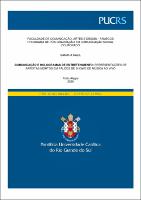| Share record |


|
Please use this identifier to cite or link to this item:
https://tede2.pucrs.br/tede2/handle/tede/9141| Document type: | Tese |
| Title: | Comunicação e hologramas de entretenimento: representações de artistas mortos em palcos de shows de música ao vivo |
| Author: | Kalil, Samara  |
| Advisor: | Tietzmann, Roberto |
| Abstract (native): | Esta tese se baseia nos usos atuais das projeções ditas holográficas em shows de música ao vivo impulsionados pela indústria do entretenimento visando investigar as experiências visuais e as representações de artistas mortos em tais apresentações. Toma como objeto as imagens projetadas de artistas mortos e discute como acontece a percepção de uma fronteira sensível ausente por meio de via imagética e tecnológica, utilizando as postulações teóricas de Belting (2010, 2015), Debray (1993) e Baudrillard (1995, 1996a, 1996b). Dividida em quatro capítulos, desenvolve nos dois iniciais um resgate em torno dos primeiros usos da técnica, tendo como base o seu desenvolvimento histórico-cultural e engloba a antropologia das imagens por meio do olhar e entendimentos sobre a morte, a representação e a simulação (RICHARSON; WILTSHIRE, 2018; JOHNSTON, 2016; BURDEKIN, 2015; DOMINGUES, 2003, 2009; MANNONI, 2000; CRARY, 2012; VIRILIO, 2014; PARENTE, 2013; VILLAFAÑE, 2006; COUCHOT, 1993). O virtual, a performance digital, a metalepse e o estranhamento também são conceitos estudados no fenômeno pelas vias de Schechner (2013), Dixon (2007), Taylor (2012), Pier (2016), Wolf (2016), Hofer (2011), Mori (2012), Jones, Benett e Cross (2015). No terceiro capítulo, enfoca uma estratégia metodológica voltada para o campo da Comunicação, em conjunto com um mapeamento de apresentações dos últimos 30 anos ligadas ao objeto de análise. Por último, apresenta dois momentos de observação e análise: a) com performances holográficas gravadas em vídeo de artistas falecidos ocorridas ao vivo; e b) em um show ao vivo em Londres, no ano de 2019, através de uma observação participante. Como resultado, indica um esquema de entendimento perceptivo para essa forma de imagem ao vivo – enquadrada como holograma de entretenimento –, que ocorre “em ciclo” na experiência perceptiva atual, com movimentos metalépticos que devem/podem ser considerados/avaliados. Propõe, assim, que os artistas falecidos já conseguem por meio do sistema modelizador da imagem holográfica reconfigurar em parte a lógica da morte se mantiverem uma distância segura em relação ao fã/público para que não sejam uma presença estranha. |
| Abstract (english): | This thesis is based on actual uses of holographic projections impulsed by the entertainment industries to investigate visual experiences and deceased artists representations in these events discussing how the perception of an absent sensitive frontier occurs by imagery and technology through Belting (2010, 2015), Debray (1993) and Baudrillard (1995, 1996a, 1996b). The work is structured in four chapters in which the first two reviews the former uses of the holographic technique grounded in historiccultural development and encompassing the anthropology of the images through comprehension the concepts of death, representation, and simulation (RICHARSON; WILTSHIRE, 2018; JOHNSTON, 2016; BURDEKIN, 2015; DOMINGUES, 2003, 2009; MANNONI, 2000; CRARY, 2012; VIRILIO, 2014; PARENTE, 2013; VILLAFAÑE, 2006; COUCHOT, 1993). The virtual, digital performance, metalepsis, and strangeness are studied concepts in the phenomenon using Schechner (2013), Dixon (2007), Taylor (2012), Pier (2016), Wolf (2016), Hofer (2011), Mori (2012), Jones, Benett & Cross (2015) references. The third chapter develops a methodologic strategy aiming at the communication field, mapping the past 30 years related to the researched object. The last chapter presents two points of observation and analysis: a) holographic performances recorded from videos of deceased artists occurred live; b) a live show in London 2019, from an observer's point of view. As a result, it indicates a schema of perceptive – understanding to this form of live image as an entertainment hologram – that occurs in “a circle” perspective experience, with metaleptic moves that should/can be considered/evaluated. Therefore, it proposes that the deceased artists already manage, through the holographic image modeling system, to partially subvert the logic of death if they maintain a safe distance from the fan/audience avoiding being a strange presence |
| Keywords: | Comunicação Holograma Imagem Estranhamento Metalepse Communication Hologram Image Uncanny valley Metalepsis |
| CNPQ Knowledge Areas: | CIENCIAS SOCIAIS APLICADAS::COMUNICACAO |
| Language: | por |
| Country: | Brasil |
| Publisher: | Pontifícia Universidade Católica do Rio Grande do Sul |
| Institution Acronym: | PUCRS |
| Department: | Escola de Comunicação, Arte e Design |
| Program: | Programa de Pós-Graduação em Comunicação Social |
| Access type: | Acesso Aberto |
| Fulltext access restriction: | Trabalho não apresenta restrição para publicação |
| URI: | http://tede2.pucrs.br/tede2/handle/tede/9141 |
| Issue Date: | 13-Mar-2020 |
| Appears in Collections: | Programa de Pós-Graduação em Comunicação Social |
Files in This Item:
| File | Description | Size | Format | |
|---|---|---|---|---|
| KALIL_Samara_Comunicação e hologramas de entretenimento.pdf | SAMARA_KALIL_TES | 4.86 MB | Adobe PDF |  Download/Open Preview |
Items in DSpace are protected by copyright, with all rights reserved, unless otherwise indicated.




